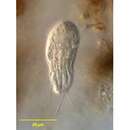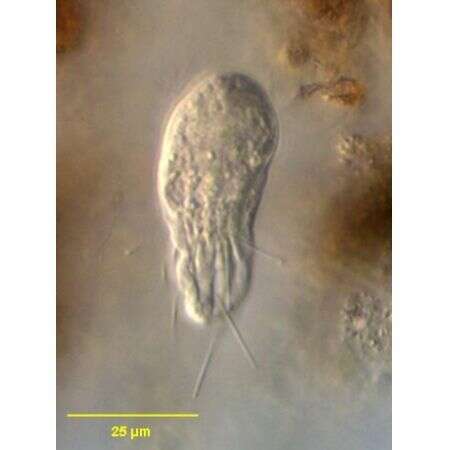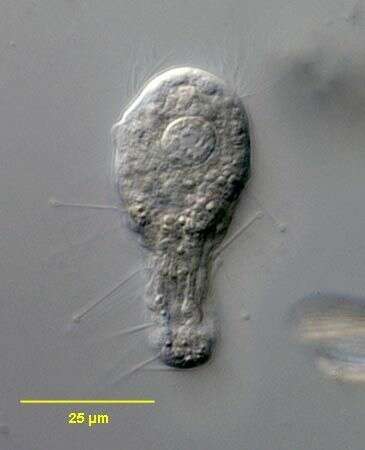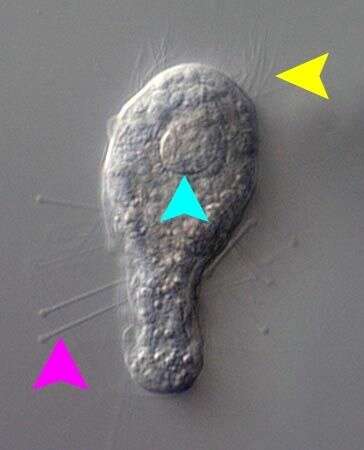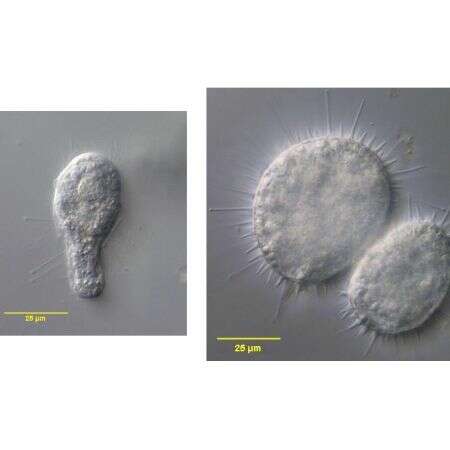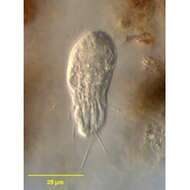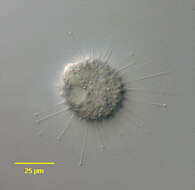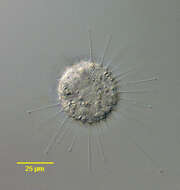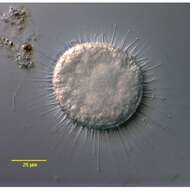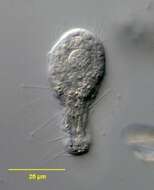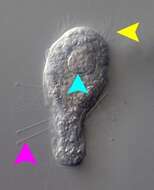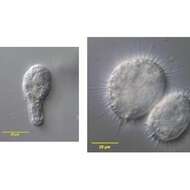-
n vivo view of the swarmer of the suctorian, Parapodophrya soliformis (LAUTERBORN,1908) KAHL,1931. The swarmers have numerous capitate tentacles arising randomly from the body posterior to the anterior subapical ciliary wreath. The body has longitudinal irregular pellicular wrinkles. Collected from sapropelic bottom sediments of a stagnant freshwater pond near Boise, Idaho 43°40â 57.20â N 116° 15â 15.44â W . September, 2006.DIC.
-
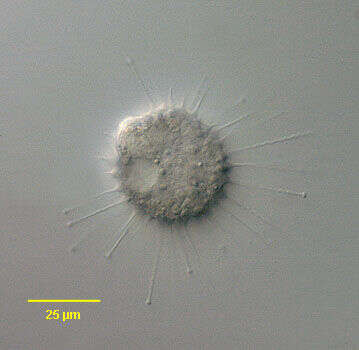
Portrait of the exogenid suctorian, Parapodophrya soliformis (Lauterborn,1908)Kahl,1931.This is a tentative identification.Members of this genus usually have a very fine stalk but sometimes this is absent (as in this example).A firm diagnosis requires identification of the swarmer cell which is elongate, the anterior end wider than the posterior. There is an anterior wreath of cilia in the swarmer.The cell body is roughly spherical with tentacles distributed over the entire surface rather than in fascicles. The tentacles widen at their bases giving the cell a serrated outline. Only the extended tentacles are capitate. When they contract they appear as short wide-based spines Seen best here at 12 o'clock). These features are also typical of this species of Parapodophrya.The single contractile vacuole is seen at 8 o'clock here. The spherical macronucleus (not well seen here) is central. Parapodophrya species are free-living and never parasitic unlike Podophrya.Collected from sapropelic bottom sediments of a freshwater aquaculture tub near Boise, Idaho.December 2005.DIC.
-
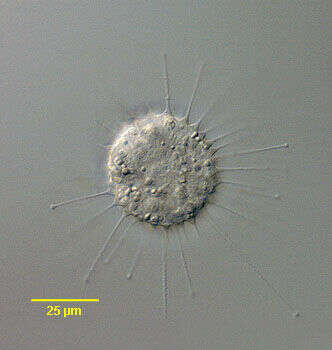
Portrait of the exogenid suctorian, Parapodophrya soliformis (Lauterborn,1908)Kahl,1931.This is a tentative identification.Members of this genus usually have a very fine stalk but sometimes this is absent (as in this example).A firm diagnosis requires identification of the swarmer cell which is elongate, the anterior end wider than the posterior. There is an anterior wreath of cilia in the swarmer.The cell body is roughly spherical with tentacles distributed over the entire surface rather than in fascicles. The tentacles widen at their bases giving the cell a serrated outline. Only the extended tentacles are capitate. When they contract they appear as short wide-based spines Seen best here at 10 o'clock). These features are also typical of this species of Parapodophrya.The single contractile vacuole is eccentric (not seen here). The spherical macronucleus (not well seen here) is central. Parapodophrya species are free-living and never parasitic unlike Podophrya.Collected from sapropelic bottom sediments of a freshwater aquaculture tub near Boise, Idaho.December 2005.DIC.
-

Portrait of the exogenid suctorian, Parapodophrya soliformis (Lauterborn,1908)Kahl,1931.This is a tentative identification.Members of this genus usually have a very fine stalk but sometimes this is absent (as in this example).A firm diagnosis requires identification of the swarmer cell which is elongate, the anterior end wider than the posterior. There is an anterior wreath of cilia in the swarmer.The cell body is roughly spherical with tentacles distributed over the entire surface rather than in fascicles. The tentacles widen at their bases giving the cell a serrated outline. Only the extended tentacles are capitate. When they contract they appear as short wide-based spines. These features are also typical of this species of Parapodophrya.There is a single contractile vacuole. The spherical macronucleus (not well seen here) is central. Parapodophrya species are free-living and never parasitic unlike Podophrya.Collected from sapropelic bottom sediments of a freshwater aquaculture tub near Boise, Idaho.December 2005.DIC.
-
In vivo view of the swarmer of the suctorian, Parapodophrya soliformis (LAUTERBORN,1908) KAHL,1931. The swarmers have numerous capitate tentacles arising randomly from the body posterior to the anterior subapical ciliary wreath. The body has longitudinal irregular pellicular wrinkles. Collected from sapropelic bottom sediments of a stagnant freshwater pond near Boise, Idaho 43°40â 57.20â N 116° 15â 15.44â W . September, 2006.DIC.
-
In vivo view of the swarmer of the suctorian, Parapodophrya soliformis (LAUTERBORN,1908) KAHL,1931. The swarmers have numerous capitate tentacles (pink arrowhead) arising randomly from the body posterior to the anterior subapical ciliary wreath (yellow arrowhead). The body has longitudinal irregular pellicular wrinkles. The ellipsoid nucleus is seen in cross-section here (light blue arrowhead).Collected from sapropelic bottom sediments of a stagnant freshwater pond near Boise, Idaho 43°40â 57.20â N 116° 15â 15.44â W . September, 2006.DIC.
-
In vivo views of the swarmer (left) and the adult form, recently divided (right) of the suctorian, Parapodophrya soliformis (LAUTERBORN,1908) KAHL,1931. Both collected from sapropelic bottom sediments of the same stagnant freshwater pond near Boise, Idaho 43°40â 57.20â N 116° 15â 15.44â W . September, 2006.DIC.

